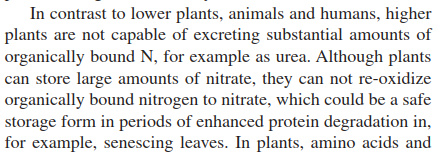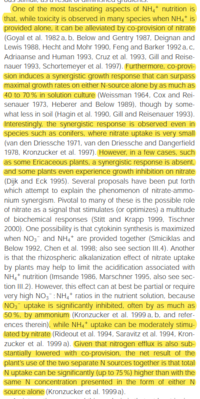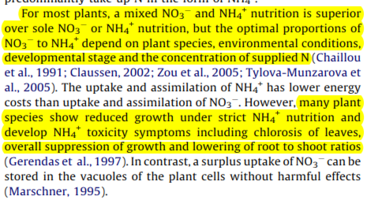Thanks, does 46% urea mean that i need to double the amount of the ifc calculator ?Hi all,
You need to be a little bit careful, because cheaper urea prills often <"have biuret present">.
cheers Darrel
-
You are viewing the forum as a Guest, please login (you can use your Facebook, Twitter, Google or Microsoft account to login) or register using this link: Log in or Sign Up
You are using an out of date browser. It may not display this or other websites correctly.
You should upgrade or use an alternative browser.
You should upgrade or use an alternative browser.
With what replace KNO3 ?
- Thread starter eminor
- Start date
Hi all,
The 46% comes from the <"proportion of nitrogen in urea">.
cheers Darrel
That, 46%, is the <"nitrogen (N) content of urea (CO(NH2)2)">, so I'm guessing the prill is actually 100% urea?Thanks, does 46% urea mean that i need to double the amount of the ifc calculator ?
The 46% comes from the <"proportion of nitrogen in urea">.
cheers Darrel
In the IFC Calculator:Thanks, does 46% urea mean that i need to double the amount of the ifc calculator ?
John q
Member
Seriouslyplants cannot convert ammonium into nitrate
here is what they say about itHi all,
That, 46%, is the <"nitrogen (N) content of urea (CO(NH2)2)">, so I'm guessing the prill is actually 100% urea?
The 46% comes from the <"proportion of nitrogen in urea">.
cheers Darrel
Urea Technical with 46% nitrogen is used as a nitrogen fertilizer especially on summer crops. In the form of homogeneous pearls and associated with an anti-motant, Urea has the advantage of being spread in a regular way.
_Maq_
Member
Share them. I’m keen.Not sure whether I've understood the context but plants cannot convert ammonium into nitrate.
In general, I've studied more than just a few papers on the question of nitrate vs. ammonium nutrition of plants, esp. submerged plants. In sum, it is believed that aquatic plants slightly prefer ammonium, yet in most instances, plants grew best when both ammonium and nitrates were available.
The issue is not that simple just to say 'assimilating ammonium is less demanding energetically'. There are circumstances which must be included into account.
The obvious caveat to every single post ever written by every single hobbyist is that things cannot be generalized to every species.
Certainly, the natural environment will dictate the mechanisms present in a plant.
I don’t dispute that there exists an optimal ratio given a particular species. However, it wouldn’t make much evolutionary sense if the mechanism did not exists: it could be less efficient and cost more energy or even be unable to keep up with any demand unless metabolic rates were increased.
I would be rather interested - leveraging Leidbig’s - if we could compensate any of the observations by supplementing higher co2 levels and/or all nutrients associated with the mechanisms —- I say co2 as undoubtedly, it has the highest probability of making a difference.
No matter how you slice it, if you don’t provide the exact amount for a fixed moment of time, there is an associated cost (and that will be energy) — glucose, co2, etc.
Josh
_Maq_
Member
In fact, plants differ by outer appearance much much more than by their physiology. Proteins and enzymes are largely the same in all higher plants. The reactions they execute are the same, and so are the energetic budgets.The obvious caveat to every single post ever written by every single hobbyist is that things cannot be generalized to every species.
There's much more to that. External conditions existing in every moment can influence the energetic balance of many processes. Par example, while uptaking nitrate, a proton is co-transported. That is energetically 'cheaper' in acidic environment - full of protons. On the other side, when ammonium is taken up, a proton is exported. That is easier in basic environment. Similarly, the presence and intensity of light, the presence and concentration of certain other ions, even the concentration of CO2 influence the plant's choice at every moment. (That's why Diana Walstad's statements on this issue are primitive and scientifically incorrect.)I don’t dispute that there exists an optimal ratio given a particular species.
These are very detail-oriented statements.In fact, plants differ by outer appearance much much more than by their physiology. Proteins and enzymes are largely the same in all higher plants. The reactions they execute are the same, and so are the energetic budgets.
Two bodies also have the same insides … yet they function completely different under different conditions.
Energetic budgets for the specific mechanisms may be unique, but it is not so simple. You require certain constituents, you have reaction rates, you have concentration gradients affecting the efficacy and yields of these reactions.
There's much more to that. External conditions existing in every moment can influence the energetic balance of many processes. Par example, while uptaking nitrate, a proton is co-transported. That is energetically 'cheaper' in acidic environment - full of protons. On the other side, when ammonium is taken up, a proton is exported. That is easier in basic environment. Similarly, the presence and intensity of light, the presence and concentration of certain other ions, even the concentration of CO2 influence the plant's choice at every moment. (That's why Diana Walstad's statements on this issue are primitive and scientifically incorrect.)
I suppose we should add the other caveat to every post ever written - it depends on the environment and is unique to all that stuff.
This is an interconnected web and dynamic system —
Thanks for your marchner post ps. Won’t take it at face value — not sure it makes an evolutionary sense to negate the ability entirely … the efficacy of the mechanism sure … but a system has access to different forms of N even if you just “dose” NO3 … decay … substrate … fish … etc.
_Maq_
Member
The enzyme which would enable such reaction is known to exist in bacteria but not in higher plants.Won’t take it at face value — not sure it makes an evolutionary sense to negate the ability entirely
Maybe it would come as a surprise to you, but there are many seemingly good things that higher plants cannot do.
John q
Member
Thankfully I don't run my tank on this theory...View attachment 191359
Taken from Marschner.
I've suggested plants can convert amonnia to no3. You've quoted me a quack paragraph stating plants don't excrete urea.. to quote monty python.... I fart in your general direction sir.
_Maq_
Member
Not surprised.The enzyme which would enable such reaction is known to exist in bacteria but not in higher plants.
Maybe it would come as a surprise to you, but there are many seemingly good things that higher plants cannot do.
Cheers,
Josh
Pretty sure I’ve said all this …View attachment 191369
Taken from Britto, Kronzucker - NH4 toxicity in higher plants. A critical review [2002]
View attachment 191370
Taken from Brix - Nitrogen nutrition of Canna indica. Effects of ammonium versus nitrate [2010]
ElleDee
Member
Y'all, I don't always agree with @_Maq_ , but the fact that plants uptake nitrate and then have to reduce it to ammonium to use it, not the other way around is super basic plant science and highly conserved across plant lineages. There are so many things that vary by species, including which nitrogen source is preferred, but this a very fundamental building block of how plants work.
Hi all,
I really <"enjoy these threads">, and I think the research done by @_Maq_ , @Geoffrey Rea & @Roland is invaluable, but personally I'm really not too bothered about which <"form of fixed nitrogen"> we give our plants. I can't imagine any of us are ever going to <"add enough TAN"> to cause plant issues. Additionally, with certain provisos, we can estimate the amount of stored nitrate (<"luxury uptake">) by <"plant colour">.
I've got a method that works for me, just ensure your <"dissolved oxygen supply"> always exceeds your (potential) <"Biochemical Oxygen Demand (BOD)">. I just think plants (including some with the <"aerial advantage">) are the <"easiest way of doing this">.
It isn't <"very exciting">, but <"it works"> and is <"accessible to every-one">. I want people to keep <"successful planted tanks">, because planted tanks make the <"rest of aquarium keeping so much easier"> and more enjoyable.
cheers Darrel
<"That one">.but the fact that plants uptake nitrate and then have to reduce it to ammonium to use it, not the other way around is super basic plant science and highly conserved across plant lineages.
I really <"enjoy these threads">, and I think the research done by @_Maq_ , @Geoffrey Rea & @Roland is invaluable, but personally I'm really not too bothered about which <"form of fixed nitrogen"> we give our plants. I can't imagine any of us are ever going to <"add enough TAN"> to cause plant issues. Additionally, with certain provisos, we can estimate the amount of stored nitrate (<"luxury uptake">) by <"plant colour">.
I've got a method that works for me, just ensure your <"dissolved oxygen supply"> always exceeds your (potential) <"Biochemical Oxygen Demand (BOD)">. I just think plants (including some with the <"aerial advantage">) are the <"easiest way of doing this">.
It isn't <"very exciting">, but <"it works"> and is <"accessible to every-one">. I want people to keep <"successful planted tanks">, because planted tanks make the <"rest of aquarium keeping so much easier"> and more enjoyable.
cheers Darrel





